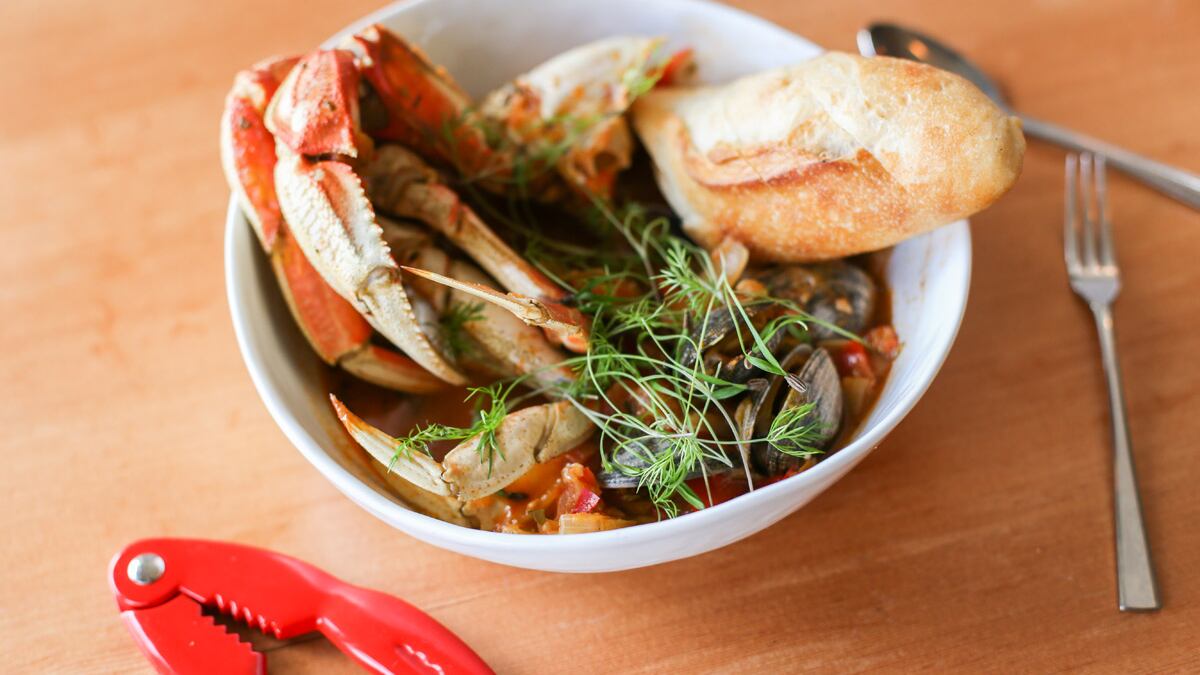Alongside the bastard stepchildren of Los Angeles—the Korean taco and the California roll—cioppino is the West Coast's only homegrown food tradition that matters, the only one we made for ourselves.
The first time Jacqueline chef Derek Hanson tried it, he couldn't believe what he was tasting.
Hanson grew up in Denver, but accompanying his father on a business trip to San Francisco, he got his first taste of the Italian-style, fiery-hot tomato-and-wine broth brimming with fish and shells and crab legs fresh from the Pacific.
"I come from a landlocked state," he says. "I'd never had anything like it."
Neither has most of the country. Although some easterly fish houses serve a version, often one much closer to that found in Italy, cioppino remains tied to the specific bounty of the Pacific: our King and Dungeness crabs, our bountiful mussels and delicate oysters.
Like all of us here on the edge of the country, cioppino began as a somewhat fishy stew of leftovers, steeped in alcohol.

The way the story goes, the Italian fishermen of old San Francisco used to make a communal pot at the end of the day, each fisherman adding a bit of leftover seafood to an herbed brine of wine, garlic, onion and tomato: a mussel or clam here, a crab leg there, a hulking hunk of whitefish to boot.
It was called "ciuppin"—the word for "chop" and "little soup." By the '20s, it was San Francisco's signature restaurant dish, and it spread up and down the coast.
Though I grew up hundreds of miles north of its birthplace, the spicy Genoese-style peasant soup remains the only food I think of as my birthright. My father discovered it through an old Sunset magazine article, and when I was young our family ate cioppino just once a year, in September or October. It was the brief moment in Oregon when the seasons for tomatoes and shellfish converged. We invited everybody we knew—especially people with boats who would now owe us favors—to come eat a mammoth pot of the stuff.
Salty's, Cabezon, Gino's, Mama Mia and RingSide Fish House each have their own versions, as do 20 other seafood and Italian spots all over town.
"But none of the new, young, hip spots are making it," Hanson says. "It's all the old-school places." On a West Coast not used to maintaining its traditions—or even having them to begin with—the existing fan base for cioppino looks a bit like a convention for General Motors car salesmen, enthusiastic and devoted to better days.
Southeast Clinton Street's Jacqueline is the first Portland restaurant in years to make cioppino a trademark, even if the stylish hall of spicy-smoky cocktails, delicate butterfish and shiitake-bottarga salads may seem an unlikely home for an updated take on a dish often eaten with the help of pliers. But Jacqueline's cioppino is the best I've had in a restaurant.

And it happened almost by accident. Hanson had planned to serve a bouillabaisse, but the classic French fish stew was too complicated and time-consuming to make sense for his restaurant. He went with cioppino in part because it was simpler.
But it quickly got complicated. Early versions of the soup came out too thin, Hanson says. And the seasons were a problem. Shells and especially local Dungeness crab are best in the winter, tomatoes in late summer.
He hit on the idea of preserving tomatoes, and drying them in the oven overnight, while deriving most of his water not from tomatoes but from his cooked-down jus of mussels and the wine he adds in the braise. The result was a denser flavor: more tomato, more thickness, more seafood, more everything.
But, Hanson says, "the thing that makes cioppino is the heat."
Hanson discovered that researchers at the Oregon State University Food Innovation Center had begun fooling around with growing Peruvian aji amarillo peppers on Sauvie Island.

The farming experiment worked. "But they never came back for the peppers," Hanson says.
So now they're in Jacqueline's kitchen.
Hanson made an aji amarillo concentrate that tastes like the molten core at the center of life itself: bright, vinegary, citric. This is the source of most of the cioppino's heat, but the acid burst of flavor also brings out that dense, garlicky tomato, wine, onion, Herbsaint fennel and garden pepper stock that forms the base of his broth.

It is a blockbuster—the first cioppino since I was 8 years old that has offered that same heart-shaking sense of discovery. It also indulges that affinity, natural to coastal people, for the primitive crack of shell and tomato spatter up to your neck, amid swirling herb and a touch of fire.
"Honestly, I thought more people would complain about the mess," Hanson says. "Really, it's what keeps my restaurant in business. The old-school fish-house fare lets me experiment, make fancier things elsewhere on the menu. You can't just be fancy everywhere."
Jacqueline, 2039 SE Clinton St., 503-327-8637, jacqeulinepdx.com.

Why Are Tokyo Ramen Shops Suddenly Taking Over Portland?
We Tried 39 Bowls of Portland Ramen—These Are the Very Best, By Style
Pono Farm's Shabu Shabu Takes Portland Hot Pot To A New Level
Are You Confused About Hot Pot? Here's How Long You Should Cook Everything For
Tournant's Pozole Night is a Soul-Warming Event Built On Locally Made Hominy
The Epic Journey of the Family Behind Ha VL, Portland's Most Famous Broth Masters
Three Soups At Ha VL You Must Try
Jacqueline Is Reviving Cioppino, The West Coast's Sloppiest, Spiciest, Fishiest Soup
Lagman Is the Ramen of Central Asia, And One of Portland's Rarest Exotic Soups
The Kenny & Zuke's Chef Reveals How to Make His Much-Loved Hungarian Mushroom Soup
The XLB Soup Dumpling Craze Is Finally Coming To Portland

